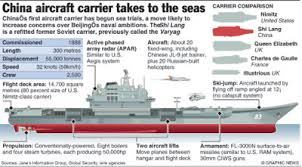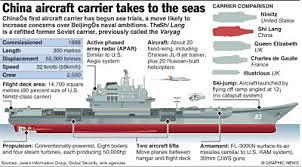China: World's Largest Aircraft Carrier Docks in South China Sea
Whether or not Beijing targets super power USA in order to overtake it in economic and military terms, one thing is very transparent from its moves in Asia: veto power China is gradually and steadily maintaining its supremacy in Asia. In order to showcase its military power China is focusing on South China Sea by adding more and more military installations there in a sustained manner. This obviously threatens the regional powers that fear the Chinese regional hegemony could be devastating for them in future.
China has been feverishly piling sand onto reefs in the South China Sea for the past year, creating seven new islets in the region. It is straining geopolitical tensions that were already taut. The speed and scale of China’s island-building spree have alarmed other countries with interests in the region. So far China has built port facilities, military buildings and an airstrip on the islands. The installations bolster China’s foothold in the Spratly Islands, a disputed scattering of reefs and islands in the South China Sea more than 500 miles from the Chinese mainland.
China has already completed work on a 700 meter-long and the world’s largest dock at its sprawling Sanya naval complex in Hainan province in the South China Sea. According to an Asian security magazine Kanwa Asian Defence report, the dock is able to service ships on both sides, allowing it to accommodate two aircraft carriers or other large ships at the same time. China’s state-run media said that the aircraft carrier dock had been completed in November 2014. The base incorporates a pier which can dock large ships on both sides, suggesting that two carriers can dock at the PLA Navy's carrier bases at the same time.
America’s aircraft carrier docks in Norfolk, Virginia, as well as its carrier base in Japan, were between 400 and 430 meters long. The 700 meter-long Chinese dock would make the new dock the longest in the world. A Chinese defense official confirmed the reports during a press briefing on Friday. In response to a question about the Western report, Yang Yujun, a spokesperson for China’s Defense Ministry, said that the onshore support facilities includes docking ports for the aircraft carriers, airports, training facilities and so on. Chinese officials had previously said that construction on the aircraft carrier base began in 2012, and China’s sole aircraft carrier, the Liaoning, docked at the Hainian base briefly in September 2013. The Liaoning’s home port is at the Dalian naval base in northern Liaoning province.
According to the Kanwa report, the new dock is connected to the PLA Navy’s Yulin nuclear submarine base, making the Sanya complex the largest naval base in all of Asia. It is also strategically located in the South China Sea. Li Jie, a Beijing-based naval expert said that China is still likely to further expand the Sanya base to cater to other vessels. So far it is just able to accommodate two-way rapid replenishment for two aircraft carriers. The fact that the dock can accommodate two aircraft carriers is further confirmation that China is building additional aircraft carriers. The location of the Sanya base, in the South China Sea, demonstrates that China intends to use the aircraft carriers to project power further from its shores. Li Jie added: “China will finish two home-built aircraft carriers, and more large vessels will join those two to form fighting flotillas. That means that more docks and ports need to be ready not only in the south but also in the north."
China claims nearly the entire South China Sea, parts of which are also claimed by the Philippines, Vietnam, Malaysia and Brunei. China also has overlapping claims with Indonesia but Jakarta does not officially consider itself to be a claimant to the South China Sea dispute.
Incidentally, Yang Yujun, the Defense Ministry spokesperson, accused the USA of trying to militarize the South China Sea. "China is extremely concerned at the United States' pushing of the militarization of the South China Sea region. " What they are doing can't help but make people wonder whether they want nothing better than chaos. Yang made the comments in reference to recent US military drills in the South China Sea. China’s military also conducted a massive military drill in the South China Sea this week, but Yang insisted these were routine and not directed at any third party.
Territorial disputes in the South China Sea involve both island and maritime claims among several sovereign states within the region, namely Brunei, the People's Republic of China, the Republic of China (Taiwan), Malaysia, the Philippines, and Vietnam. There are disputes concerning both the Spratly and the Paracel islands, as well as maritime boundaries in the Gulf of Tonkin and elsewhere. There is a further dispute in the waters near the Indonesian Natuna Islands. The interests of different nations include acquiring fishing areas around the two archipelagos; the potential exploitation of suspected crude oil and natural gas under the waters of various parts of the South China Sea; and the strategic control of important shipping lanes. Shangri-La Dialogue serves as the "Track One" exchange forum on the security issues surrounding Asia-Pacific region including Territorial disputes in the South China Sea
As tensions in the region continue to mount, China and the Association of Southeast Asian Nations or ASEAN have agreed to set up a foreign ministers' hotline to tackle emergencies in the disputed South China Sea. On 4 November 2002, the 10 member states and China signed a Declaration on the conduct of parties in the South China Sea but little progress has been made in turning this into a Code of Conduct.
The hotline proposal is expected to be announced at the 10 nation bloc's meeting of foreign ministers. The hotline is believed to be the first involving China. The Philippines and Vietnam already have a naval hotline which was set up last year to monitor the disputed waters.
ASEAN leaders hope the emergency hotline will help defuse the tension provoked over naval encounters with China and its claims to the disputed territories, an official said. The proposed hotline was discussed at a meeting of senior diplomats from China and ASEAN in Tianjin last week.
The South China Sea is the centre of a long running territorial dispute between several Asian countries and China which is claiming most of the area.. The archipelago comprising about 750 islands and reefs is believed to be rich in oil and gas resources. It is also about to complete land reclamation works in the area, heightening tension in the region. China seized Scarborough Shoal from the Philippines in 2012 after a three month standoff with the Philippine navy.
The disputed Spratly Island, where China is building seven man-made islands, is 145 nautical miles from Scarborough Shoal, making it an ideal base for Philippines to monitor China's movements in the region.
Recently China undertook a 10 day drill in the disputed parts of the area and warned neighbouring countries not to enter the region until the war games were over. This has led to Philippines beefing up its navy forces, including re-opening Subic Bay as a navy base from next year, more than 20 years after it kicked out the US and shut down the military base which is now used as an economic zone.
Comments
There are 0 comments on this post














